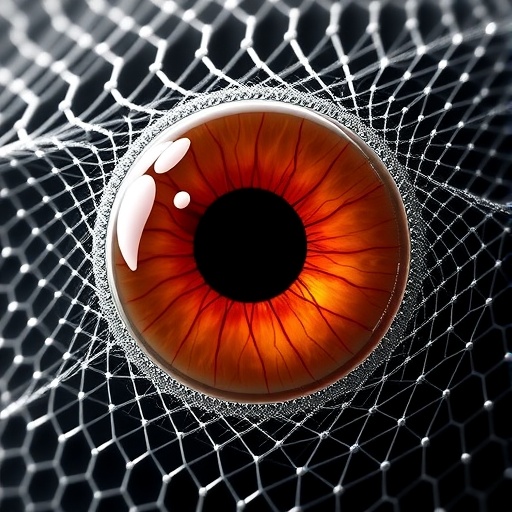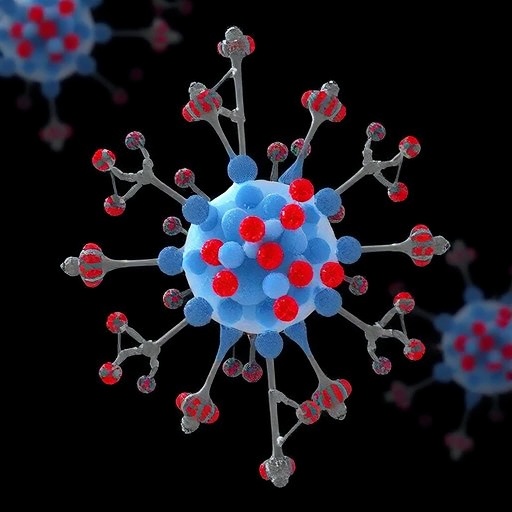In a remarkable stride toward combating retinal degenerative diseases, a groundbreaking study has demonstrated that graphene oxide-enhanced copolymeric nanoimplants can significantly boost phototransduction efficiency and restore visual function in animal models afflicted with retinitis pigmentosa. This pioneering research addresses one of the most intractable challenges in neurodegenerative ophthalmology: the progressive loss of photoreceptors leading to irreversible blindness. The advent of nanomaterial-augmented retinal implants heralds a new era where restoration of sight may become feasible for millions suffering from hereditary and acquired retinal dystrophies.
Retinitis pigmentosa (RP) encompasses a diverse group of inherited retinal disorders characterized by the gradual degeneration of rod and cone photoreceptors. As these vital photoreceptors perish, patients experience night blindness, peripheral vision loss, and eventual central vision deterioration. Conventional therapeutic strategies have largely been palliative, aimed solely at slowing disease progression through gene therapies or retinal prosthetics, but none have effectively restored lost photoreceptor function. The integration of cutting-edge nanomaterials into retinal implants marks a significant paradigm shift toward functional rehabilitation.
Central to this innovation is the use of graphene oxide (GO), a two-dimensional carbon allotrope renowned for its exceptional electrical conductivity, biocompatibility, and unique physicochemical properties. When incorporated into copolymeric nanoimplants designed to interface with retinal neurons, GO dramatically enhances the phototransduction cascade’s efficiency—the biochemical process that converts photons into electrical signals in the retina. This enhancement augments the sensitivity and responsiveness of the nanoimplant, improving signal fidelity and neural stimulation precision.
These copolymeric nanoimplants are fabricated from meticulously engineered polymers that mimic the mechanical properties of retinal tissue, ensuring seamless integration with the host retina and minimizing inflammatory responses. The copolymer matrix provides a flexible scaffold supporting the conductive graphene oxide nanosheets, collectively forming a hybrid interface that optimizes light absorption and charge transfer. The synergy between the polymer and GO creates a bioelectronic platform tailored for photonic-neural communication within degenerated retinal environments.
Preclinical validation employed both rat and pig models of retinitis pigmentosa, providing robust translational insights. Rodent models, with their well-characterized genetic mutations mirroring human RP, allowed detailed mechanistic studies, whereas pig models—with retinal dimensions and architecture closely resembling that of humans—served to demonstrate scalability and functional outcomes relevant to clinical applications. Implantation in these models led to significant improvements in electrophysiological markers such as electroretinogram (ERG) amplitudes and visually evoked potentials (VEPs), indicating restored photoreceptive activity.
The implantation protocol involved minimally invasive surgical techniques that placed the nanoimplant in close proximity to the degenerated photoreceptor layer, maximizing the interface with surviving retinal neurons. Postoperatively, animals exhibited markedly improved visual behaviors, including enhanced optokinetic reflexes and navigation capabilities under low-light conditions. These behavioral correlates validated the electrophysiological and histological data, substantiating genuine functional vision restoration attributable to the nanoimplant’s operation.
Mechanistically, the presence of graphene oxide within the copolymeric matrix facilitated increased charge carrier mobility and reduced recombination losses, thus amplifying the photocurrent generated under illumination. This photocurrent enhancement directly translated into a stronger and more sustained activation of downstream bipolar and ganglion cells—the neural conduits transmitting visual information to the brain’s visual cortex. Importantly, the implant’s biocompatibility was confirmed through histopathological evaluations, revealing a lack of deleterious inflammatory or fibrotic responses.
Beyond electrical enhancement, the study revealed that GO’s intrinsic properties fostered an improved microenvironment for retinal cell survival. The antioxidant and anti-inflammatory capacities of graphene oxide mitigated secondary degenerative processes, potentially slowing ongoing cell death and preserving the residual retinal architecture. This dual function—electronic augmentation coupled with neuroprotection—positions GO-copolymeric nanoimplants as multifunctional therapeutic agents beyond mere prosthetics.
This research also breaks new ground in the realm of nano-bioelectronics, demonstrating how advanced materials engineering can be harnessed to directly interface artificial devices with delicate neuronal tissues. The fine-tuned balance of mechanical compliance, electrical conductivity, and biological compatibility achieved in this system exemplifies the next generation of retinal prostheses. Moreover, the modular nature of the nanoimplant design opens avenues for further customization, including integration with light sources tailored to specific wavelength sensitivities or the addition of bioactive molecules to enhance cellular regeneration.
While clinical translation remains on the horizon, this study sets a compelling precedent for future human trials. The results suggest that incorporating graphene oxide into nanoimplant technologies could overcome major limitations that have hindered retinal prosthetics, such as low signal quality, poor tissue integration, and limited longevity. The scalability of the fabrication method combined with the use of biocompatible materials paves the way for scalable manufacturing under clinical-grade standards.
Ethical considerations and regulatory pathways will be integral components of advancing this technology to patient care. Safety profiles, long-term stability in human retinal tissue, and detailed immunological responses will require exhaustive characterization in preclinical and early-phase clinical studies. Nonetheless, the convergence of nanotechnology, biomaterials science, and neurobiology exemplified by this work offers unprecedented hope for restoring vision and improving the quality of life of patients afflicted with devastating retinal diseases.
In summary, the integration of graphene oxide into copolymeric nanoimplants represents a pioneering breakthrough in retinal prosthetics, combining enhanced phototransduction efficiency with biocompatibility and neuroprotective properties. The dramatic restoration of visual functions observed in rat and pig models of retinitis pigmentosa underscores the transformative potential of this approach. This research lays a solid foundation for the future development of advanced nanoengineered devices capable of reversing blindness and restoring sensory perception at a level previously unattainable.
Such advancements not only push the boundaries of current scientific knowledge but also embody a visionary approach where nanotechnology and regenerative medicine coalesce to address complex neurodegenerative disorders. The prospect of restoring vision through biohybrid implants equipped with sophisticated nanoengineered materials will undoubtedly ignite widespread interest across scientific disciplines and inspire new lines of inquiry into neural interface technologies.
As this exciting field evolves, ongoing investigations will likely focus on optimizing material compositions, improving implantation strategies, and integrating feedback mechanisms that allow dynamic adjustment to neural activity. With sustained interdisciplinary collaboration and technological innovation, graphene oxide-enhanced nanoimplants stand poised to revolutionize treatment paradigms and offer tangible solutions to blindness—a profound societal impact with transformative implications for medicine and human wellbeing.
Subject of Research: Enhancement of phototransduction efficiency and functional vision restoration in retinal degeneration models using graphene oxide-based copolymeric nanoimplants.
Article Title: Graphene oxide increases the phototransduction efficiency of copolymeric nanoimplants and rescues visual functions in rat and pig models of Retinitis pigmentosa.
Article References:
Galluzzi, F., Francia, S., Cupini, S. et al. Graphene oxide increases the phototransduction efficiency of copolymeric nanoimplants and rescues visual functions in rat and pig models of Retinitis pigmentosa. Nat Commun 16, 8721 (2025). https://doi.org/10.1038/s41467-025-63716-4
Image Credits: AI Generated
Tags: advanced therapies for retinal disordersbiocompatible nanomaterials in medicineelectrical conductivity in ophthalmic devicesfunctional rehabilitation for vision lossgraphene oxide in retinal implantshereditary retinal dystrophies treatmentnanoimplants for retinitis pigmentosaneurodegenerative ophthalmology innovationsphototransduction efficiency enhancementprogressive photoreceptor degeneration solutionsrestoring vision with nanomaterialsretinal degenerative disease research





